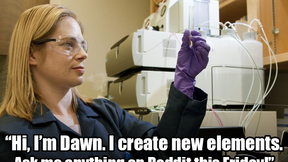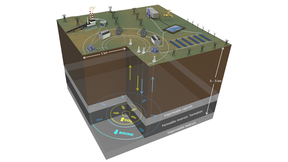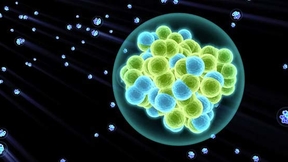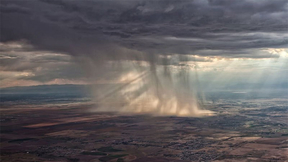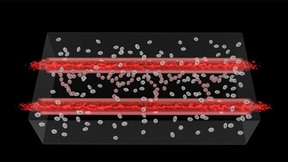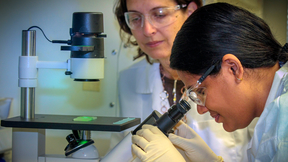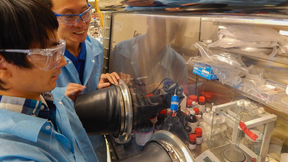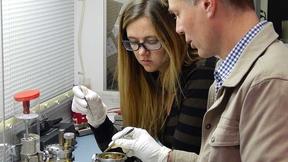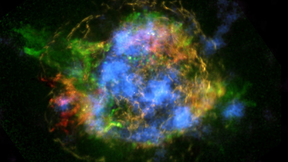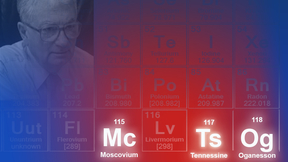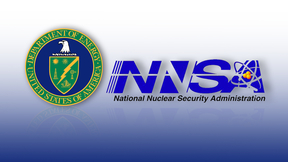Back
Physical and Life Sciences
Lawrence Livermore to work on DOE research program for electric grid modernization
Lawrence Livermore National Laboratory researchers will be working on 14 new grid research projects as part of the Grid Modernization Laboratory Consortium announced Thursday by Energy Secretary Ernest Moniz.Moniz released a blueprint for modernizing the grid, which is built on its Grid Modernization Initiative, an ongoing effort that reflects the Obama Administration’s…
Ask this chemist about creating new elements
Ever wonder how scientists create new elements, add them to the periodic table or why they’re even interested in super heavy elements?Dawn Shaughnessy, Lawrence Livermore’s principal investigator for the Heavy Element Group, will field questions from the public on the popular social media site Reddit from 10 a.m. to noon PST on Friday, Jan. 8.Shaughnessy is part of an…
'Underground battery' could store energy, CO2
Meeting the Paris Climate Agreement goal of limiting the increase in the global average temperature to well below two degrees Celsius compared to pre-industrial levels will require increased use of renewable energy and reducing the CO2 intensity of fossil energy use.The intermittency of when the wind blows and when the sun shines is one of the biggest challenges impeding…
Lawrence Livermore credited with discovery of elements 115, 117 and 118
The International Union of Pure and Applied Chemistry (IUPAC) has confirmed that Lawrence Livermore National Laboratory scientists and international collaborators have officially discovered elements 115, 117 and 118.The announcement means those three elements are one step closer to being named.Lawrence Livermore teamed with the Joint Institute for Nuclear Research in Dubna…
New results from experimental facility deepen understanding of dark matter
LEAD, S.D. – The Large Underground Xenon (LUX) dark matter experiment, which operates nearly a mile underground at the Sanford Underground Research Facility (SURF) in the Black Hills of South Dakota, has already proven itself to be the most sensitive dark matter detector in the world. Now, a new set of calibration techniques employed by LUX scientists has further improved…
Researchers develop a new mathematical tool for analyzing and evaluating nuclear material
Lawrence Livermore National Laboratory scientists have created a new method for detecting and analyzing fission chains to assess and evaluate nuclear material.The powerful mathematical tools enable the team to detect, analyze and assess unknown objects containing fissionable material in a wide range of applications, from safeguards and border security, to arms control and…
Climate models overestimate rainfall increases
Lawrence Livermore researchers and collaborators have found that most climate models overestimate the increase in global precipitation due to climate change.Specifically, the team looked at 25 models and found they underestimate the increase in absorption of sunlight by water vapor as the atmosphere becomes moister, and therefore overestimate increases in global…
Researchers 3D print 'living' blood vessels
The cardiovascular system is a complex web of tens of thousands of miles of arteries, capillaries and veins, branching throughout the body like tributaries of a great river. And now, researchers at Lawrence Livermore National Laboratory are recapitulating this intricate network using an emerging technology: 3D bioprinting."It’s going to change the way we do biology," said…
Scientists discover shifts in climate-sensitive plankton over the past millennium
Past and current climate change has affected the food sources in the surface waters in the North Pacific Ocean.New research by Lawrence Livermore National Laboratory and colleagues at the University of California, Santa Cruz, University of Colorado and Universität zu Kiel in Germany, have found that there are distinct differences in how plankton respond to climate over the…
Kenneth Turteltaub named 2015 AAAS fellow
Kenneth Turteltaub of Lawrence Livermore National Laboratory has been named a fellow of the American Association for the Advancement of Science (AAAS).Turteltaub was specifically noted for the development of ultra-precise accelerator mass spectrometry (AMS) methods for biomedicine and work on carcinogenesis, the formation of macromolecules and low-dose pharmacokinetics …
PLS climate scientist reflects on 20 years of climate-change science
In a letter to the editors of Nature published in the November 12, 2015, edition of that journal, Lab climate scientist Ben Santer reflects on the impact of the 1995 Intergovernmental Panel on Climate Change (IPCC) 2nd Assessment Report, the lessons learned, and progress made since then in detecting and attributing the causes of observed changes in global climate. Santer…
Protein curbs spread of prostate cancer to bone
Scientists from Lawrence Livermore National Laboratory, in collaboration with researchers from University of California campuses at Merced and Davis, have found that a specific secreted protein inhibits prostate cancer metastasis to bone.Their research appears in recent editions of the journals, PLOS ONE and Microarrays.Prostate cancer is the most frequently diagnosed…
Using hydrogen to enhance lithium ion batteries
Lawrence Livermore National Laboratory scientists have found that lithium ion batteries operate longer and faster when their electrodes are treated with hydrogen.Lithium ion batteries (LIBs) are a class of rechargeable battery types in which lithium ions move from the negative electrode to the positive electrode during discharge and back when charging.The growing demand…
Lab-Johns Hopkins team tapped to work on possible NASA effort to explore asteroid
Two LLNL scientists are part of a scientific team that has been chosen as one of five finalists for a possible NASA Discovery Program mission.The two Livermore scientists, physicist Morgan Burks and nuclear engineer Lena Heffern, a graduate student, are teamed with researchers from The Johns Hopkins University Applied Physics Laboratory (JHUAPL) on a proposal to explore a…
An X-Ray Eye on Universes
Answers to many scientific mysteries lie in realms invisible to the human eye. Clues to some of the most fundamental questions in astronomy, cosmology, and nuclear science lurk in sections of the electromagnetic spectrum outside the small slice of wavelengths one can see.
Seven Lawrence Livermore researchers named 2015 fellows of the American Physical Society
Seven Lawrence Livermore National Laboratory (LLNL) scientists have been selected as 2015 fellows of the American Physical Society (APS).The new fellows represent a wide selection of physics expertise, ranging from laser-plasma interaction to optical techniques to computational condensed matter. APS fellowships are awarded after extensive review and are considered a…
Lab scientists discover five new nuclei
Lawrence Livermore scientists, in conjunction with international researchers, have discovered five new atomic nuclei to be added the chart of nuclides.The study, conducted this fall, focuses on developing new methods of synthesis for super heavy elements. The newly discovered, exotic nuclei are one isotope each of heavy elements berkelium, neptunium and uranium and two…
David Bader elected fellow of AMS
Climate scientist David Bader has been elected a fellow of the American Meteorological Society (AMS).Election to the grade of AMS fellow recognizes outstanding contributions to advance atmospheric and related sciences, technologies, applications and services for the benefit of society."I feel honored to have been recognized by my peers, which I believe is the most…
NNSA fellowship in honor of Ian Hutcheon
The Office of Defense Nuclear Nonproliferation (DNN) has established a fellowship in honor of the late Ian Hutcheon, a longtime employee of Lawrence Livermore National Laboratory. This fellowship will be a two-year assignment as a Junior Professional Officer (JPO) in support of the International Atomic Energy Agency’s (IAEA) Division of Nuclear Security."To the nuclear…
Event honors 20 years of Stockpile Stewardship
The proven success of the Stockpile Stewardship Program (SSP) – which pushed the limits of modern science and engineering by requiring the transition from explosive nuclear weapons testing to what is effectively virtual nuclear testing – was celebrated Wednesday at a half-day public event hosted by the Department of Energy’s National Nuclear Security Administration (NNSA)…



